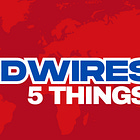Australia's Radio Networks Just Made Podcast Buying Easier Than BVOD. Let That Sink In.
This piece is freely available to read. Become a paid subscriber today and help keep Podwires financially afloat so that we can continue to pay our writers for their insight and expertise.
Podwires Rundown : Commercial Radio & Audio just launched CRA Audio ID, and if you’re not paying attention to what’s happening in Australia’s digital audio market, you should be. Four major networks—ARN, Nine Audio, Nova Entertainment, and Southern Cross Austereo—unified their inventory into a single cross-network identity solution now trading on Google’s Display & Video 360. The result? 14.7 million monthly addressable listeners with better scale than both BVOD and ad-supported Spotify combined. While American podcast networks continue fragmenting their sales approaches, Australia’s radio broadcasters just demonstrated what happens when competitors decide collaboration beats market share squabbling.
Commercial Radio & Audio (CRA) announced the launch of CRA Audio ID in a company release, detailing how the unified identity solution operates across Display & Video 360 to reach Australia’s digital audio audiences. The initiative, developed in partnership with Google and GfK, aggregates live streaming radio and podcast inventory from Australia’s four largest commercial audio networks into a single programmatic buying workflow. Source data comes from CRA’s October 2025 addressable audience measurements powered by GfK, with comparative scale metrics from Nielsen CMV Survey 6 2025.
The Key Points:
CRA Audio ID delivers 14.7 million monthly addressable listeners across live streaming radio and podcasts, providing greater scale than both BVOD and ad-supported Spotify in the Australian market—a metric that fundamentally challenges assumptions about where audio sits in programmatic hierarchy.
Four competing networks unified their premium inventory (ARN, Nine Audio, Nova Entertainment, Southern Cross Austereo) into a single buying workflow, eliminating the fragmentation that typically forces advertisers to negotiate separate deals and manage multiple insertion orders for audience reach.
The solution trades through Google’s Display & Video 360, meaning agencies and marketers can now plan, buy, and optimize digital audio campaigns alongside other media channels within existing programmatic workflows rather than requiring specialized audio buying expertise or separate platforms.
Privacy-safe identity management enables cross-network frequency capping and audience deduplication, solving the fundamental programmatic audio problem where listeners streaming multiple networks or shows traditionally got hammered with redundant ad impressions because no one could track exposure across properties.
The initiative proves broadcast radio networks can move faster on unified identity solutions than podcast-native platforms, demonstrating that traditional media companies understood the programmatic imperative while podcast networks continued debating whether aggregation dilutes brand value.
Why It Matters: When advertisers want to buy podcast inventory at scale, they typically face a choice: work with Spotify or YouTube for closed ecosystem reach, negotiate with individual networks for premium shows, or cobble together programmatic deals across fragmented suppliers. CRA Audio ID demonstrates that a third path exists—competing networks can maintain brand independence while creating unified buying infrastructure that makes audio as accessible as display or video. For an industry constantly complaining that audio buying is “too hard” compared to other digital channels, Australia’s radio networks just removed that excuse for their market. The success or failure of this approach will determine whether other regions follow suit or continue treating audio as specialty inventory requiring bespoke expertise.
The Big Picture :
For podcasters and producers, CRA Audio ID represents what unified discoverability could look like on the monetization side—your show becomes part of larger addressable inventory pools without losing attribution or direct relationships. This matters because agencies planning integrated campaigns increasingly default to whatever’s easiest to execute programmatically, and if audio requires specialized knowledge or fragmented buys, you lose budget to channels that don’t. Australian podcasters now benefit from their shows being packaged alongside premium radio streaming inventory that agencies already understand and trust, potentially accessing automotive, CPG, and financial services budgets that typically ignore podcast-only proposals.
For the broader industry, this launch exposes an uncomfortable truth about American podcasting’s programmatic evolution. While US networks debate whether aggregation diminishes brand equity and publishers worry that unified buying reduces CPMs, Australia’s commercial radio sector just proved that competitive networks can collaborate on infrastructure without sacrificing premium positioning. The fact that this solution delivers better scale than BVOD—a format advertisers readily embrace despite fragmentation—suggests the barrier to audio adoption isn’t audience size but buying friction. If CRA Audio ID demonstrates material efficiency gains without cannibalizing direct sales, expect pressure on American audio publishers to follow suit. The alternative? Watch budgets continue flowing to Spotify and YouTube, where scale and simplicity trump everything else.
Fair play to Australia for showing the rest of us what industry collaboration actually looks like when everyone stops protecting territory long enough to make the medium more accessible. Now let’s see if anyone else has the guts to follow.
Not ready to be paid subscribe, but appreciate the newsletter ? Grab us a beer or snag the exclusive ad spot at the top of next week's newsletter.






